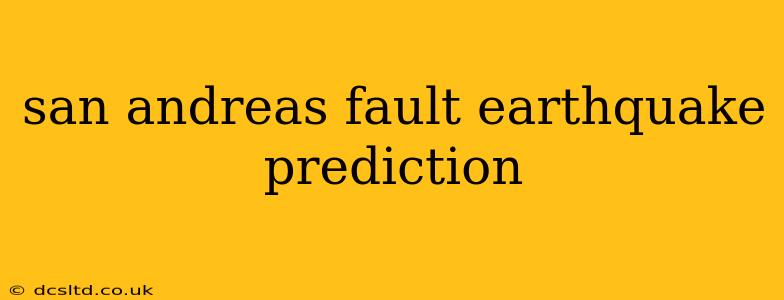The San Andreas Fault, a major continental transform fault extending roughly 800 miles through California, is a constant reminder of the seismic potential lurking beneath our feet. The question of when the next major earthquake will strike along this fault is one that scientists, policymakers, and the public grapple with constantly. Unfortunately, precise earthquake prediction remains elusive, despite significant advances in our understanding of fault mechanics and seismic activity. This article explores the current state of San Andreas Fault earthquake prediction, the challenges involved, and the ongoing efforts to improve our preparedness.
Can We Predict Earthquakes on the San Andreas Fault?
No, we cannot currently predict earthquakes on the San Andreas Fault (or anywhere else) with the accuracy needed to issue timely warnings. While we can forecast the probability of a large earthquake occurring within a certain timeframe and geographic region, pinpointing the exact date, time, and magnitude remains beyond our capabilities. This lack of precision stems from the complexity of the Earth's crust and the intricate processes leading up to seismic rupture.
What Methods Are Used to Assess Earthquake Risk on the San Andreas Fault?
Scientists employ various methods to assess earthquake risk along the San Andreas Fault:
- Paleoseismology: Studying the geologic record to identify past earthquakes and their recurrence intervals. This helps estimate the long-term average frequency of large earthquakes.
- GPS Measurements: Precise GPS stations monitor ground deformation, providing insights into the accumulation of strain along the fault. Increased strain indicates a higher likelihood of a future earthquake.
- Seismic Monitoring: A dense network of seismometers constantly monitors ground shaking. Changes in seismic activity can sometimes indicate increased stress buildup, but this is not a reliable predictor of imminent large earthquakes.
- Stress Modeling: Sophisticated computer models simulate stress distribution along the fault, helping to identify areas of higher risk.
What are the Challenges in Predicting Earthquakes on the San Andreas Fault?
Several significant challenges hinder accurate earthquake prediction:
- Complexity of Fault Systems: The San Andreas Fault is not a single, continuous structure. It comprises numerous segments with varying characteristics and levels of stress accumulation.
- Heterogeneity of the Earth's Crust: The physical properties of rocks vary significantly along the fault, influencing stress propagation and rupture initiation.
- Unpredictable Trigger Mechanisms: While stress buildup is a necessary condition for earthquakes, the precise trigger mechanism (e.g., a small earthquake, fluid pressure changes) often remains unknown.
- Limited Data and Observation Time: Our observational record of earthquakes is relatively short compared to the timescale of fault rupture cycles.
How is Earthquake Forecasting Different from Earthquake Prediction?
Earthquake forecasting differs significantly from earthquake prediction. Forecasting provides probabilities of earthquakes within a specified timeframe and geographic area. It's based on statistical analyses of past earthquake activity, geological data, and other observations. In contrast, prediction aims to specify the exact time, location, and magnitude of a future earthquake, a capability we currently lack.
What is the Probability of a Large Earthquake on the San Andreas Fault in the Next 30 Years?
Scientists have estimated a high probability of a significant earthquake (magnitude 7 or greater) occurring on the San Andreas Fault within the next 30 years. However, the precise location and timing remain uncertain. It's crucial to remember that this is a probability, not a guarantee.
How Can We Prepare for a Large Earthquake on the San Andreas Fault?
Given the inability to accurately predict earthquakes, focusing on preparedness is paramount. This includes:
- Developing and regularly practicing earthquake safety plans.
- Securing heavy objects in your home.
- Having an emergency kit with supplies such as water, food, and a first-aid kit.
- Understanding how to react during an earthquake.
- Participating in community-based preparedness efforts.
While the precise prediction of San Andreas Fault earthquakes remains a challenge, ongoing research and improved monitoring techniques are continuously enhancing our understanding of earthquake processes and enabling better risk assessment. This, coupled with robust preparedness strategies, is crucial for mitigating the impacts of future earthquakes along this significant fault line.
